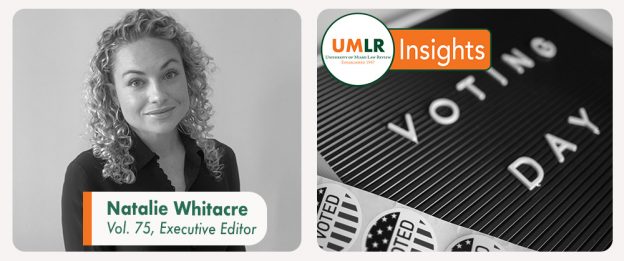NATALIE WHITACRE—“We are not seeking perfection. We are seeking a more perfect union.” – Rob Richie (President and CEO of Fair Vote)
In the last two of the five U.S. presidential elections, the winner of the electoral votes—and ultimately the presidency—was not the winner of the national vote. Additionally, much of the presidential campaign battle is fought in just twelve states, ultimately controlling the outcome of our elections. To some, this feels undemocratic, leaving many unsettled about the accuracy of the Electoral College. Recently, a movement to alter the way our Executive is elected has taken flight and U.S. voters, like Rob Richie, are attempting to design a “more perfect union.”
The Electoral College is one of the most divisive constitutionally established systems and has been the subject of hundreds of proposed constitutional amendments throughout U.S. history.
The method by which the president of the United States is elected continues to be a hotly debated topic, and there is a possibility that this method may change before our next presidential election.
The Electoral College was first created during the Constitutional Convention in 1787 as a result the “Great Compromise,” which sought to balance the power of large states and small states. The Founders forewent a pure popular vote system, which would benefit larger states, in favor of a system that would give smaller states a greater voice. As a part of this compromise, the Founders designed a unique system of electing the Executive: The Electoral College. Through the Electoral College, presidential electors appointed by the states would each cast votes for the president. Article II section 1 of the Constitution establishes the structure of the Electoral College, which allots a number of electors equal to each state’s Congressional delegation.
Under Article II section 1, clause 3, each state is granted complete discretion to select a method of appointing electors. Today, all but two states (Maine and Nebraska) employ a “winner takes all” approach, which allows the party of the presidential candidate that receives the most votes in that state to select all of that state’s electors.
The National Popular Vote Interstate Compact (“the Interstate Compact”) is a recent movement that seeks to utilize the authority of the states granted under Article II, section 1 to essentially render the Electoral College system irrelevant. The Interstate Compact is an agreement among states to award all of their electoral college votes to the presidential candidate who wins the national popular vote. However, in order for the Interstate Compact to have effect, it would need at least 270 electoral votes among the signatory states—the number of votes required to win the presidential election. Currently, the Interstate Compact has been adopted in 16 jurisdictions, amounting to 196 electoral votes.
The Interstate Compact strategy attempts to change the rules of the election process without actually amending the constitution. But, the question of legality rises to the forefront. Under the Compact Clause of Article I section 10, no state can enter into compacts or agreements with another state without the approval of Congress. The contours of this law requiring for congressional consent have been defined through case law. Virginia v. Tennessee, 148 U.S. 503 (1893); U.S. Steel Corp. v. Multistate Comm’n Tax, 434 U.S. 452 (1978). The Supreme Court has determined that the Compact Clause is limited to agreements or compacts that would “enhance the political power of the member States in a way that encroaches upon the supremacy of the United States.”
Under the Compact Clause, congressional approval may not be necessary because the compact does not affect federal power; the Constitution already grants states plenary authority to select electors. Thus, the signatory states are not exercising more power than already bestowed to them by the Constitution.
The Interstate Compact may nevertheless be considered a violation of the Compact Clause because the Interstate Compact induces drastic transformation in the process by which our executive is elected. The Constitution deliberately eschews immediate election by national popular vote and firmly establishes a system of indirect election by representatives meant to embody the views of a state. The Interstate Compact would essentially allow voters to elect the president directly. Collectively, the states would be changing the function of a system explicitly described in the Constitution—a process exclusively reserved for Constitutional amendment.
However, in a recent Supreme Court decision regarding “faithless electors,” the Court upheld the power of the states to appoint electors in any manner that they choose. Writing for the majority, Justice Kagan explained, “Article II, section 1’s appointments power gives the States far-reaching authority over presidential electors . . . [E]ach state may appoint electors ‘in such Manner as the Legislature thereof may direct.’ This court has described that clause as conveying the ‘broadest power of determination’ over who becomes an elector.” The Court’s opinion made clear that states have broad authority to make laws regarding their electoral processes.
Regardless of any changes in the system of electing the president, a multitude of legal issues hang in the balance. The “Great Compromise” created the Electoral College, but any proposed solutions will require great compromise too. Any changes to the process will undoubtedly arrive with new concerns. It remains to be seen whether the National Popular Vote system will drive the U.S. toward a more perfect union.






